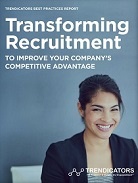
Organizations displaying high RESPECT—the organizational attributes employees most want—deliver outsized external and internal performance.
In my last column, I shared research that revealed what employees most want from their employers. Research involving a representative sample of more than 200,000 employees in 27 countries identified these seven organizational attributes:
1. Recognition: Acknowledgment for a job well done from managers and the organization at large
2. Exciting Work: A job that is interesting, challenging, and fun
3. Security: Confidence that solid work and a well-managed organization lead to job security
4. Pay: Fair compensation for a day’s work
5. Education and Career Growth: Opportunities to develop skills over the course of a productive career
6. Conditions: A well-equipped workplace that is physically comfortable and socially inviting
7. Truth: Frank, honest, and transparent communication from managers and senior leaders
The first letters of these attributes form the acronym, RESPECT, and define, according to employees, a great work experience.
RESPECT Index Scores vs. External Measures
Naturally, organizations are going to differ in the extent to which they display these attributes. But does it matter? In other words, do organizations showing more RESPECT to their employees perform at higher levels? To answer this question, we first created the RESPECT Index, consisting of employee survey items measuring the seven RESPECT attributes:
1. My organization values my contribution. (R)
2. My work gives me a feeling of personal accomplishment. (E)
3. I feel there is a promising future for me at my organization. (S)
4. I am paid fairly for the work I do. (P)
5. My organization is helping me develop the skills I will need in the future. (E)
6. I feel I am part of a team. (C)
7. In my organization, there is open, honest, two-way communication. (T)
We next collected RESPECT Index scores from hundreds of companies. This allowed us to correlate RESPECT Index scores with various external organizational performance measures. We found that those organizations that did a better job of displaying RESPECT for their employees also achieved more satisfied customers, as measured by the American Customer Satisfaction Index, and stronger financial performance, as measured by return on assets, diluted earnings per share, and three-year total shareholder return. We further found that the stock price performance of high RESPECT organizations exceeded what was typical of organizations in the S&P 500. All differences were statistically significant.
RESPECT Index Scores vs. Internal Measures
It is not surprising that high RESPECT organizations deliver outsized external performance. It starts with employees. And when we examined internal measures of organizational performance, we found the same pattern. Compared to low-scoring RESPECT organizations, high scorers achieve employee engagement metrics that are 2.65x higher and performance confidence metrics that are 1.83x higher.
Employee engagement is the extent to which employees are motivated to contribute to the success of the organization and are willing to apply discretionary effort to accomplish tasks important to achieving organizational goals. Performance confidence is the extent to which employees believe their organization’s products and services are consistently innovative and of higher quality than those of their competitors, that their customers are very satisfied, and that the organization competes well against others in the industry and has an outstanding future.
When organizations are creating a high RESPECT culture, they also are creating high levels of employee motivation and, consequently, high levels of both employee and organizational performance. Organizations seeking to maximize their investment in talent need to ensure they are delivering RESPECT—the seven organizational attributes employees most want in an employer.
This article originally appeared in Training Magazine!


